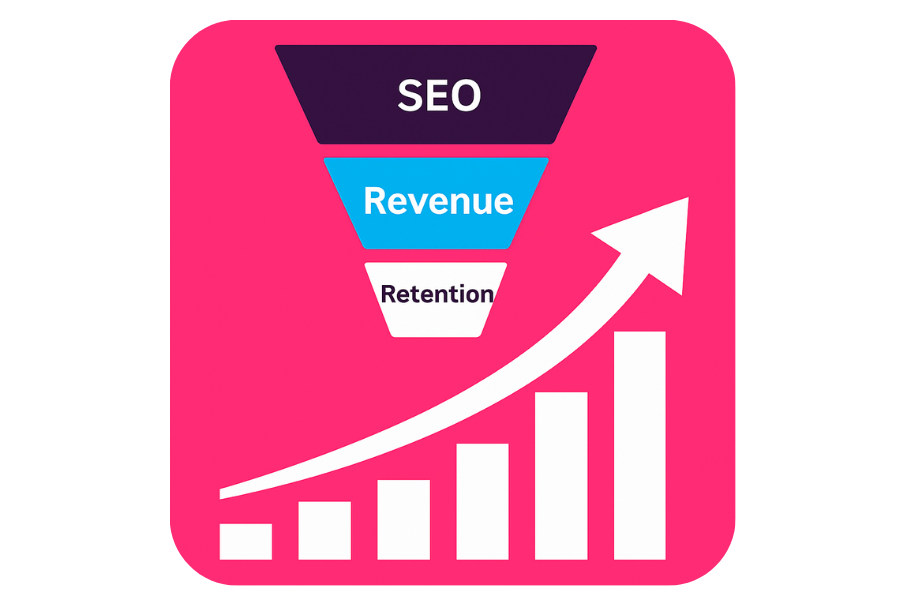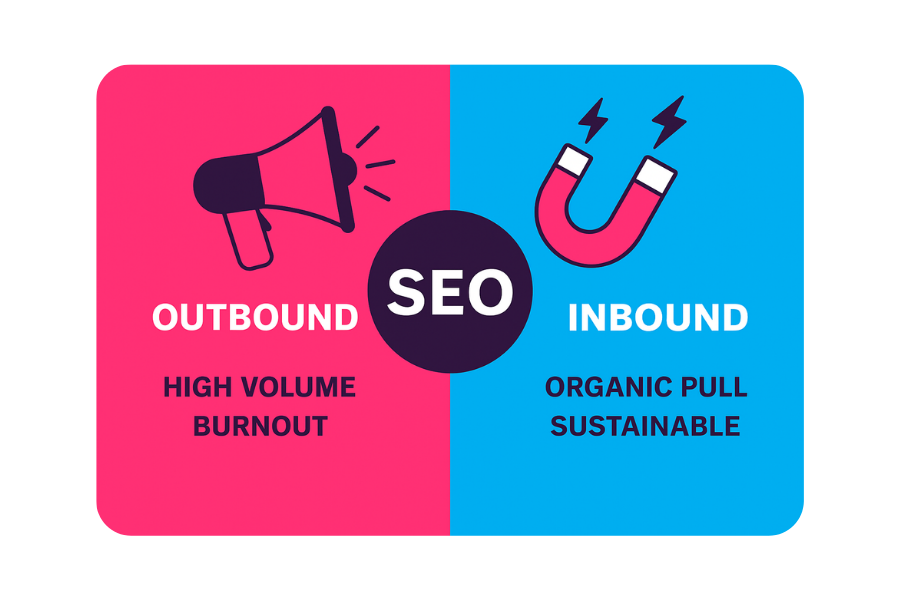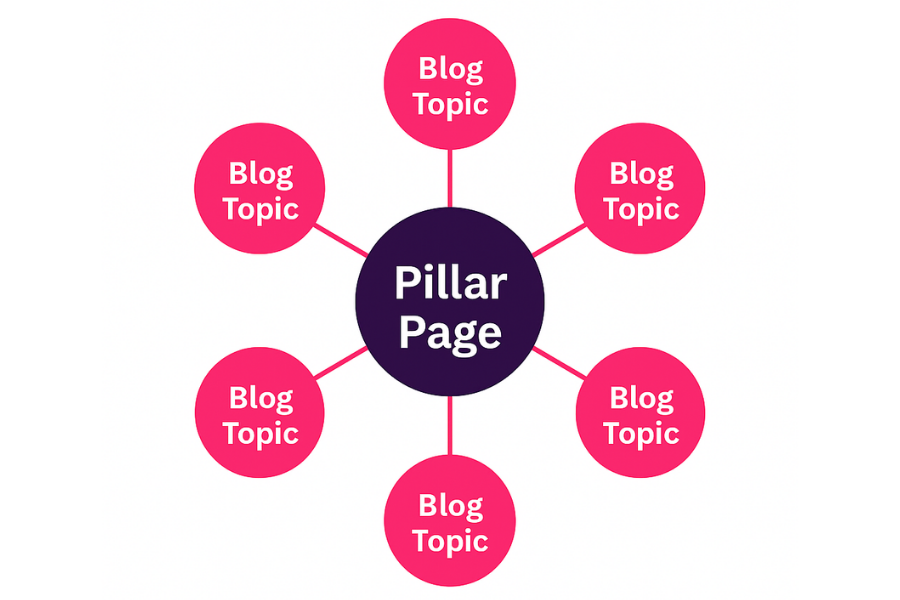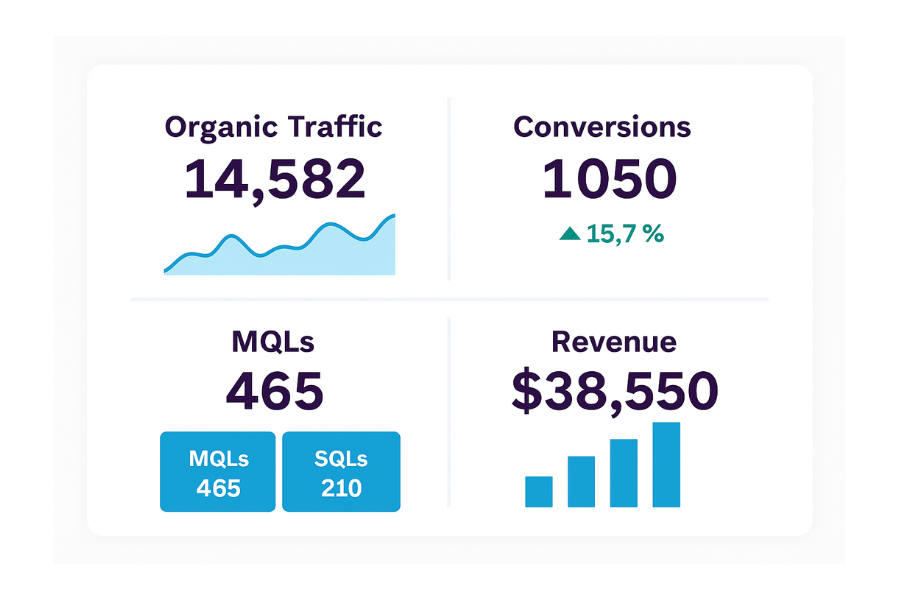For most SaaS businesses, organic search is a missed opportunity hiding in plain sight. Not because they ignore it, but because they treat it like any other content play. In reality, SEO for SaaS demands a fundamentally different approach. Why? Because your business model is different. You’re not just trying to get found, you’re trying to convert, retain, and scale.
This guide breaks down how to make SEO work across the entire customer lifecycle, from first click to loyal user. It’s built for UK-based SaaS leaders who want more than rankings. You want revenue, retention, and a partner who understands how performance marketing supports long-term growth.
At Common Ground, we help SaaS teams turn organic traffic into commercial advantage. This isn’t just about keywords, it’s about creating a search strategy that mirrors how your customers think, buy, and stay.

Why SaaS Businesses Need a Unique Approach to SEO
The average SEO playbook wasn’t written for SaaS. Most of it revolves around short sales cycles, single-purchase funnels, and keywords that chase clicks without much context. But SaaS doesn’t work like that. You’re not just trying to capture demand, you’re trying to nurture, convert, and retain users over time. That complexity changes the role of SEO entirely.
Traditional tactics, like ranking for high-volume, top-of-funnel terms, might bring in traffic. But traffic isn’t the metric that matters. Not if it doesn’t align with how your product is sold or used. This is where SaaS businesses need a different lens: one that ties SEO strategy to lifetime value, not just lead gen.
How SaaS SEO Differs from Traditional SEO
SaaS lives and dies on recurring revenue. That means success isn’t just about who finds you, but whether they stay. The SEO strategy needs to match that reality. Instead of just pulling people into the funnel, you’re building a system that supports every phase of the journey, from awareness to activation to expansion.
Most teams miss this. They focus on acquisition, optimise blog content, and chase rankings, then wonder why trial conversions or churn don’t improve. A stronger approach connects the dots: search intent to product use, landing pages to onboarding, and help content to retention. That’s the difference between traffic and traction.

Inbound vs. Outbound Marketing in SaaS
Inbound and outbound aren’t rivals; they’re tools. Outbound gives you speed. Inbound gives you scale. But here’s the rub: outbound burns out. Costs go up, attention drops, and leads rarely arrive pre-qualified. Inbound, especially through SEO, compounds.
SEO sits at the heart of sustainable inbound for SaaS. It attracts users already searching for solutions, builds authority over time, and delivers compounding returns if done strategically. It’s also one of the few channels that supports product-led growth. That might mean someone finds your tool via a “how-to” guide, signs up for a free trial, and stays because your onboarding content closed the loop.
The real power? It works while you sleep. No sales rep. No budget burn. Just content with doing the work of both educating and converting.

Building an SEO Foundation for SaaS Growth
A strong SaaS SEO strategy begins with relevance, not rankings. While keyword tools can surface demand, it’s your understanding of the customer journey that turns traffic into pipeline. In SaaS, that journey is often complex. It includes multiple touchpoints, longer decision cycles, and a post-sign-up phase that’s just as valuable as the first click.
To succeed, your content must reflect that full lifecycle. It should meet buyers where they are, whether they’re comparing tools, onboarding a team, or trying to get more value from your product.
Customer Lifecycle Stages and Search Intent
Every SaaS customer is somewhere on a spectrum, from unaware to fully onboarded. Effective SEO maps content to these stages, using search intent as the guide.
Top of the funnel (TOFU):
- Educational, problem-aware searches
- Examples: What is [category]?, [Competitor] alternatives
- Best formats: Blog posts, explainers, industry overviews
Middle of the funnel (MOFU):
- Evaluation-focused queries
- Examples: Best [category] for [industry], [Tool] vs [Tool]
- Best formats: Comparison guides, product roundups, use case pages
Bottom of the funnel (BOFU):
- Purchase-ready intent
- Examples: [Product] pricing, Start free trial
- Best formats: Pricing pages, feature breakdowns, demo CTAs
Don’t stop at acquisition. Create and optimise:
- Onboarding guides
- Product tutorials
- Expansion tips
- Support content that drives adoption
Search doesn’t end when the form is filled. For SaaS, some of your most valuable queries happen after someone becomes a user.

Marketing Funnel Optimisation
Think of SEO not just as an acquisition lever, but as part of your conversion funnel.
Good SaaS content doesn’t leave visitors stranded. It moves them forward.
Ways to connect SEO to funnel progression:
- Include CTAs that match intent (Get Demo, Compare Plans, Watch Product Tour)
- Pair content with remarketing ads based on the topic
- Offer relevant gated assets mid-way through reading
- Link across TOFU → MOFU → BOFU pages to guide movement
A blog alone won’t nurture a pipeline. Your funnel needs structure, and SEO can be the entry point to a sequenced journey.
Market Segmentation and Brand Positioning
Generic content disappears in a crowded SaaS space. The most successful SEO programmes use segmentation to dial up relevance and cut through the noise.
Tactics to localise content:
- Create content for specific sectors (e.g. project management software for agencies)
- Address distinct personas (e.g. automation for B2B RevOps leaders)
- Build clusters of related articles to own a niche
At the same time, content should reinforce your positioning. It’s not just about what you say, but how you say it.
Ask:
- Does our tone match our brand?
- Are we showing the outcomes our ICP cares about?
- Would a time-poor CMO recognise themselves in this article?
SEO isn’t just a channel. It’s where your brand often makes its first impression. Make it count.
Core Tactics for Effective SaaS SEO
With the foundation in place, it’s time to turn strategy into action. For SaaS companies, effective SEO means more than basic optimisation. It’s about building a system that mirrors how buyers search, evaluate, and engage with products like yours.
From keyword planning to technical execution, every layer needs to support discoverability, clarity, and conversion.
Keyword Research and Topic Clustering
Most SaaS teams start keyword research too broadly, chasing volume instead of intent. But in B2B SaaS, it’s the specificity that converts.
Here’s how to approach it:
Start with audience-led research:
- Interview your sales team about buyer questions
- Use tools like Ahrefs, SEMrush, or AlsoAsked to dig into real search behaviour
- Focus on problem-led queries and job-to-be-done phrases
Build topic clusters around:
- Product features: e.g. CRM automation, user permissions, SLA management
- Use cases: e.g. how to manage customer onboarding
- Industries: e.g. CRM for law firms, compliance software for fintech
Key principles:
- Prioritise long-tail keywords with clear intent
- Align content with specific stages of the lifecycle
- Use pillar pages with internal links to supporting articles for authority and structure
This isn’t just about ranking once. It’s about owning a theme across the entire journey.

Technical SEO Must-Haves
Your website is your storefront, but for SaaS, it’s also your product shelf, demo hall, and helpdesk. Technical SEO ensures search engines can access and understand it all.
Key priorities:
- Site speed and mobile performance: Google expects fast-loading, mobile-first sites. B2B buyers do too.
- JavaScript rendering: Many SaaS sites use frameworks like React or Vue. Ensure proper indexing via server-side rendering (SSR) or hydration.
- Schema markup: Implement FAQ, HowTo, and Review schema to improve click-through rates and qualify for SERP features.
- Crawl depth and structure: Flatten your site architecture to make sure key pages aren’t buried. Fix orphaned pages and broken links.
- URL hygiene: Avoid messy parameter strings and duplicate paths that confuse search engines and users alike.
Technical debt silently erodes SEO. Routine audits keep performance clean and scalable.
On-Page SEO for Conversion and Clarity
It’s not enough to rank; your pages need to convert.
Best practices for high-impact on-page optimisation:
- Headlines and metadata: Use natural language and include target keywords early. Keep titles clear and benefit-led.
- Calls to action: Match the CTA to search intent. Start Free Trial, See Pricing, or Get a Demo; each has its moment.
- Proof and reassurance: Add social proof like testimonials, customer logos, or review ratings to increase trust.
- Internal linking: Help users and bots navigate your content. Guide them from informational to commercial pages with a purpose.
Don’t write for Google. Write for buyers who are scanning, evaluating, and trying to solve a problem quickly.
Competitive Analysis
Understanding your SEO landscape is as important as understanding your buyer.
To conduct smart competitive analysis:
- Run SERP audits: Search your target terms. Note who ranks, how they structure content, and what formats win.
- Benchmark performance: Use tools to compare traffic, keyword overlap, and backlink profiles.
- Spot content gaps: Use Ahrefs’ Content Gap or SEMrush’s Keyword Gap to find terms competitors rank for, but you don’t.
- Review bottom-funnel content: Pay attention to how competitors structure pages like [Tool] vs [Tool] or [Product] pricing. That’s often where deals are won or lost.
Treat competitors as a data source, not a playbook. Learn from what they do well, and then go deeper or more relevant.
Supporting Lifecycle Metrics Through SEO
Most SaaS teams focus their SEO efforts on acquisition and stop there. But the real strength of organic content is its ability to drive value across the entire customer lifecycle. From activation to retention, well-targeted content can reduce pressure on support teams, increase product engagement, and even improve NPS.
This section breaks down how SEO can directly support your most critical lifecycle metrics: onboarding success, retention, and referrals.
User Onboarding Strategies
Onboarding is where churn begins or ends. If new users can’t find answers or experience value quickly, they’ll drop off, and often, silently.
Search-optimised onboarding content ensures users can solve problems, learn fast, and stay engaged. The bonus? This content often performs double duty: helping new sign-ups while capturing late-stage prospects evaluating how easy your product is to use.
Content to create:
- “Getting started” guides with indexed URLs (e.g. setup-guide-yourtool.com)
- Searchable video tutorials embedded with transcript markup
- Support articles are optimised for FAQs and troubleshooting queries.
Technical tip: Make sure onboarding content is crawlable and not locked behind logins. If it’s helpful, it should rank.
Churn Reduction Techniques
Reducing churn isn’t just a product or CS function; it’s a content opportunity. Some of the highest-intent queries come from existing users looking for help or trying to extract more value.
If you don’t serve that content, someone else will, possibly a competitor.
SEO content that supports retention:
- “10 ways to get more from [product name]”
- Proactive help articles addressing common friction points
- Branded search result pages that reflect product evolution (e.g. feature launches, UI changes)
Use this to intercept frustration before it becomes churn. SEO, in this case, becomes a quiet support agent working 24/7.
Referral Programmes and SEO Synergy
Referral programmes live or die on visibility. And while email and in-app prompts help, search often gets overlooked.
Create optimised landing pages that showcase your referral offer, explain how it works, and answer common questions. Use branded queries, programme terms, and intent-led titles like:
- [Product] referral programme
- Earn rewards for sharing [Product]
- How to invite a colleague to [Tool]
This also helps with user-generated content. Partners and customers searching for referral information should land on your page, not a review site, Reddit thread, or affiliate blog.
Pricing, Positioning & Conversion Through SEO
Once a prospect reaches your pricing page, the decision is near. But even here, SEO plays a crucial role. High-intent queries around cost, value, and comparisons are often the final search a buyer makes before booking a demo or starting a trial.
This stage is where conversion meets positioning, and your content needs to do both.
SEO Pages That Influence Pricing Decisions
Pricing pages often attract the most commercially valuable traffic. Yet many SaaS companies under-optimise them, treating them as simple tables rather than strategic assets.
Best practices for high-performing pricing content:
- Use structured data (schema) to enhance how the page appears in search results
- Include clear calls to action next to each plan (e.g. Start Trial, Book Demo, See All Features)
- Add contextual FAQs beneath the pricing grid to address objections
- Include logos, use cases, or testimonials aligned with each pricing tier
Buyers searching for “[product] pricing” are already solution-aware. SEO here is about clarity, trust, and nudging towards conversion.
Using SEO to Support Product-Led Growth
SEO isn’t just an acquisition channel; it’s a feature discovery engine. If you’re operating with a product-led growth (PLG) model, search can act as a silent tour guide.
Use content to show, not just tell, what your product can do. For example:
- Blog tutorials showcasing workflows (How to automate onboarding with [Tool])
- Feature pages that double as search-optimised entry points
- Contextual CTAs embedded within educational content (e.g. Try this feature, Use this template)
The goal is to reduce friction from discovery to action. When done well, SEO becomes an organic way to lead users into activation, without needing a sales touchpoint.
Formats that support PLG strategy:
- Video walkthroughs with searchable transcripts
- “How we use [Product]” articles from internal teams or power users
- Use-case clusters that pair feature education with real-world value
Positioning and conversion aren’t separate from SEO; they’re enhanced by it. The right content can shape perception, support value-based pricing, and move users towards self-serve adoption.
Analytics and Reporting for SaaS SEO
You can’t optimise what you can’t measure. And in SaaS, measuring SEO performance goes beyond rankings and traffic. You need to connect organic visibility to commercial outcomes such as pipeline, product engagement, and customer value.
This section unpacks how to build meaningful SEO reports, track the right metrics, and prove return on investment to stakeholders who care about revenue, not just sessions.
Performance Tracking and Analytics
To understand what’s working, your analytics stack needs to capture more than top-line numbers. Rankings and impressions are useful signals, but they’re not the outcome. Leads, trials, and demo bookings are.
What to track:
- Organic sessions by landing page and intent type (TOFU, MOFU, BOFU)
- Conversion rates from organic to key actions (e.g. trial start, contact form, demo request)
- Keyword visibility for branded vs non-branded terms
- Click-through rate (CTR) on high-ranking pages
- Scroll depth and time on page to gauge content engagement
Tools to use:
- GA4: for behavioural insights and conversion tracking
- Google Search Console: for visibility, click-throughs, and query performance
- Looker Studio: to build custom dashboards for stakeholders
- Ahrefs/SEMrush: to monitor keyword trends, backlinks, and SERP changes
Where possible, segment data by funnel stage. This allows you to spot drop-offs, identify intent mismatches, and focus your optimisation where it will have the biggest impact.

How to Prove ROI from SEO in SaaS
One of the toughest challenges for SaaS marketers is proving the commercial impact of organic search. Stakeholders want hard numbers. Fortunately, with the right framework, you can deliver them.
Steps to link SEO to revenue:
- Track MQLs and SQLs from organic sources via CRM or marketing automation platforms
- Attribute pipeline by mapping high-converting landing pages to deal creation
- Compare CAC (customer acquisition cost) across SEO, PPC, and paid social
- Forecast value using lead-to-close rates and average deal size from organic leads
For more advanced teams, use revenue attribution models to forecast growth:
- Predict an organic-driven pipeline using current ranking momentum
- Layer in lifetime value (LTV) to show long-term gains
- Benchmark against paid channels to show cost-efficiency
What matters most? Telling the story in business terms: leads, sales velocity, LTV, and CAC. That’s how you turn SEO from a “nice to have” into a core growth lever.
Final Thoughts: SaaS SEO Is a Long-Term Growth Engine
The best SaaS SEO strategies aren’t built for quick wins; they’re built for sustained growth. Rankings might fluctuate. Algorithms will evolve. But the compound impact of well-planned, lifecycle-aware content only gets stronger over time.
When SEO is aligned with your product, your funnel, and your customer journey, it stops being a traffic channel and starts becoming a commercial engine.
It supports:
- Lower CAC through scalable acquisition
- Higher retention via education and value reinforcement
- Faster expansion through use-case discovery
- Stronger brand recall by owning key intent-driven searches
For SaaS businesses operating in competitive markets, this is a serious edge. Especially when other channels, like paid social or outbound, face rising costs and diminishing returns.
SEO doesn’t replace those channels. It makes them more efficient.
At Common Ground, we work with SaaS teams that don’t just want visibility; they want qualified leads, improved LTV, and growth that doesn’t disappear when the ad budget does.
What you will learn in this post
Connect
More about the author

Jamie Adams
Marketing Manager
With a background in content writing and editing, working with hundreds of clients across almost a decade, Jamie helps the team with content needs, whether it's copy, socials, or a webinar.
5 Stars on Google | Trusted by growth-focused B2B Brands
Let’s Turn Strategy Into Revenue
If you’re serious about driving measurable B2B growth, we should talk.
We’ll bring the strategy. You bring the ambition.